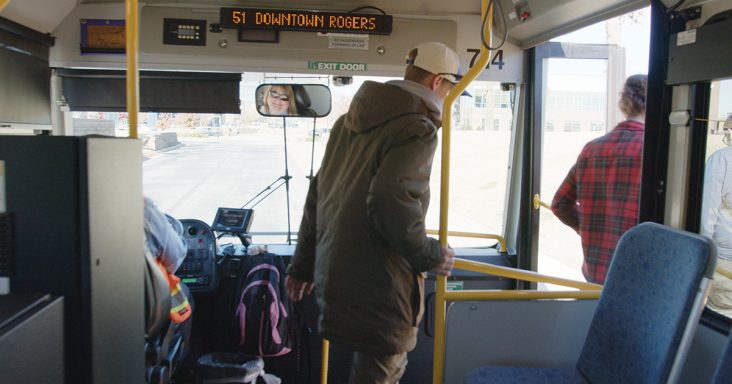Multi-modal transit significant to Walton Family Foundation’s goals
by August 6, 2024 11:42 am 386 views

The Walton Family Foundation works to support initiatives that help entities collaborate regionally on multi-modal transportation options, a senior program officer said. This will allow residents to choose whether to walk, ride a bicycle, drive a vehicle or take public transit to reach their destinations.
Meredith Bergstrom, senior program officer for the foundation’s Home Region Program, said the organization has viewed transportation and housing as interrelated issues and has worked with grant partners to address them. Household transportation and housing costs are components of the organization’s regional affordability strategy.
“Those are typically the two largest household costs that everyone faces,” Bergstrom said. “That’s certainly the case here in Northwest Arkansas. As we grow, we have seen both of those costs increase for households. And we also know that they’re related. As land values increase, people might seek to find more affordable housing further away from employment centers, from their daily destinations. And that means that their transportation costs can increase.”
The Walton Family Foundation operates on a five-year strategy, and this is the fourth year of its 2025 strategy. Specifically on transportation, it previously focused on active transportation and trails, such as the Razorback Greenway. The 2025 strategy expands on the focus to include multi-modal transportation.
“That’s really a specific emphasis on active transportation types and use multi-modal options because there are a lot of people for whom that’s not an option,” she said. “We want to lean into how do we make that an option as a region for everyone.”
To achieve its goals, the Walton Family Foundation has collaborated with cities and organizations already working on transportation initiatives, including the Northwest Arkansas Regional Planning Commission and Ozark Regional Transit.
“All of us share some common goals that are reflected in the documents like Connect Northwest Arkansas, which is a 10-year transit development plan,” Bergstrom said. “We, too, want to support those initiatives.”
PUBLIC TRANSIT PROGRESS
Citing more immediate goals, Bergstrom pointed to recent progress in public transit, such as more frequent headways “so that it’s more convenient for people to take transit,” she said. “It’s things like more people using our active transportation network for transportation and not just recreation, which is an indicator that it’s fairly convenient to bike to work.
She also highlighted the area’s first intercity route, a collaboration between Rogers and Bentonville.
According to an ORT news release, the Bentonville/Rogers Exchange (BRX) launched April 1 with six buses running at the busiest hours of the day, 84 bus stops, and a 30-minute headway. It requires no transfers and is zero-fare to all passengers. The westernmost stop is at Bentonville Community Center, and the easternmost stop is at Butterfly Park in downtown Rogers.
Bergstrom said the new route more closely aligns with transit passenger needs. She said the Walton Family Foundation didn’t directly provide financial support for the new route but gave annual support to the four largest cities in Northwest Arkansas in 2024 for expanding transit routes and maintaining those that had been expanded in the previous year. The support was provided to the cities before plans for the new route were confirmed.
“Our role was in providing support that has reflected some of the increased individual city allocations to transit each year,” she said. “And I hope what that has done is allow the cities to think more long-term with that support. … We’ve seen this tremendous increase in transit ridership, so how do we … continue to build on those successes.”
EFFICIENT TRANSIT
Joel Gardner, executive director of Ozark Regional Transit, said he’s grateful for the Walton Family Foundation’s support.
“Without their support and their ability to see what public transit could become, I don’t think we’d be where we are right now,” he said.
Gardner joked that the new route aligns more with ORT’s name as a regional transit provider. Before it was launched, ORT was more of a city-by-city transit provider. Gardner said the BRX route has been in the works for about a year. He said riders can go from one city to another without changing buses, and this is significant because transfers often lead to people missing their transfer bus.
“It’s been really good to see regional transit working in Northwest Arkansas by Ozark Regional Transit,” he said.
As of the first week of July, daily ridership on the new route has risen to 92 passengers, for a total of 3,975 passengers. Based on boarding and alighting, the top three bus stops include Bentonville Community Center (592), Hunt Tower (563), and NorthWest Arkansas Community College (559).
Gardner hopes a regional route between Springdale and Fayetteville will be in place by Jan. 1. ORT staff have worked on the new route for about two months. As new intercity routes are created, he said the next step would be establishing connector routes that feed into the intercity ones.
“We’ve established the BRX as a viable alternative to utilizing your car, shoe leather express, bicycle or in conjunction with all those things,” he said. “Now we make sure we do the right hours of the week and the right days of the week because Northwest Arkansas doesn’t shut down at 6:30 or 7 o’clock at night. It goes on ‘till 10, 11 or 12 o’clock at night, depending on the night of the week.”
